What Size Bath Fan Do I Need
Practiced stride-past-stride instructions for installing a bathroom or kitchen fan yourself, including methods of venting through a wall or roof.
Kitchens and bathrooms are particularly prone to wet problems caused by high humidity. Estrus and moisture combine to produce moisture-laden air that fills the room and, upon contacting cooler walls, and ceilings, condenses, turning back into water.
This feeds mold, mildew, and even structural rot. To expel humid air before it has a chance to condense, every bathroom needs ventilation. And kitchens need ventilation for expelling steam and cooking odors. In most cases, the best ventilation for kitchens and bathrooms is an exhaust fan or range hood. Methods for installing range hoods and bath fans are quite similar; hither nosotros focus on the techniques for installing a bathroom fan.
Though the bathrooms in about new homes are equipped with adequate bath fans, an older abode is often either entirely without a fan or has one that is underpowered. When ownership a new ventilation fan, be sure to check its rating for air movement, which is measured by cubic anxiety per minute (CFM). For an average-size bathroom, the minimal requirement is eighty CFM.
Replacing an existing fan with a new one is a relatively easy do-it-yourself project every bit long as the new unit of measurement will fit in the existing opening and can be connected to the existing exhaust duct.
Installing a new fan where in that location wasn't a fan before is more involved but oft easiest if you place it where at that place is an existing ceiling light fixture. Before you lot install the fan housing, the job will require cutting a hole in the ceiling at the light fixture'due south location, snaking a vent pipe (or duct) from there to an exterior wall, penetrating the outside wall for the vent, and adding a vent cap. For this job, purchase a fan that has a built-in calorie-free to replace the light you remove. If the ventwork is beyond your skill level, telephone call in a contractor.
Step-by-Step Bath Fan Installation
1 Turn off the power to the existing fixture at the service panel. Remove the quondam fixture. Position the template or housing on the ceiling so information technology aligns with the ceiling joist. Trace around the template or housing to locate the opening. Alternatively, if you have access from above, position the housing or template side by side to the joist and trace around information technology.
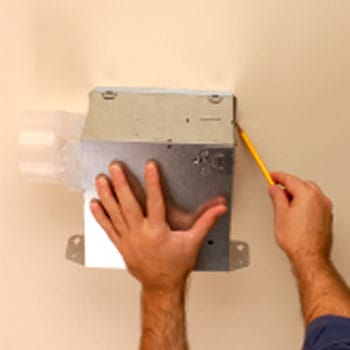
2 Cut out the opening according to the manufacturer'southward directions using a drywall saw, saber saw, reciprocating saw, or utility pocketknife.
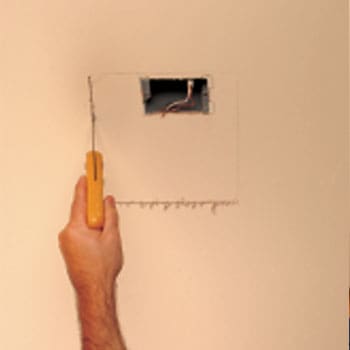
iii Attach the ductwork and insert the housing upwards into the opening. Secure the housing to the joist with the fasteners provided. Brand sure to fill all the mounting holes with fasteners to reduce vibration and ensure dissonance-gratis operation.
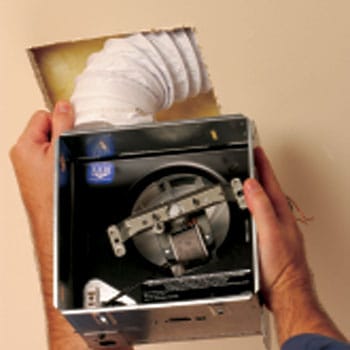
four Connect the fan unit to the existing wiring following the manufacturer'due south wiring diagram. Be sure the electric excursion is turned off when doing all work.
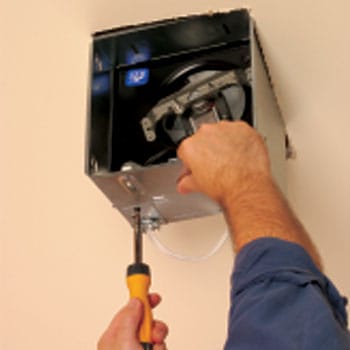
v Attach the fixture to the housing and attach the grille to the fixture with the fastener provided.
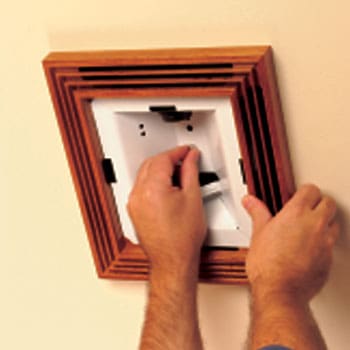
6 Spiral in a lightbulb and adhere the diffuser; this will generally only snap in place.
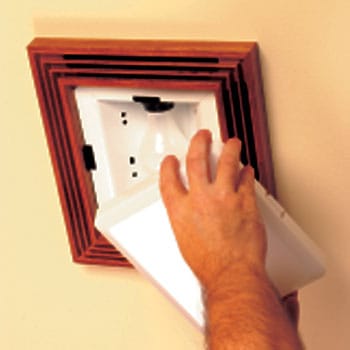
Finally, run the ductwork, making as few turns every bit possible.
Marking the location for the vent cap and cut out the hole. Utilize a bead of silicone caulk around the perimeter of the cap and slide information technology in the opening. Fasten the cap to the wall with galvanized screws. Connect the ductwork to the vent cap and examination the system.
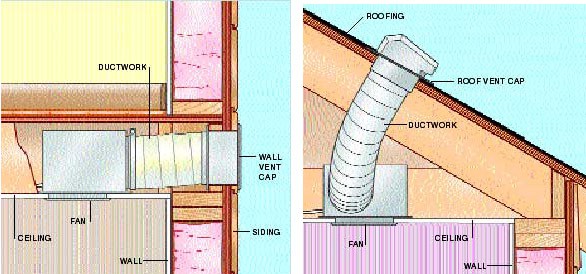
Bathroom Fan Venting Options
At that place are 2 common means to route ductwork to vent bath air outside: through the ceiling and out through an outside wall, or through the ceiling and out through the roof. (You tin besides purchase a fan that vents straight through an exterior wall, but this typically requires running a new electrical line to the wall.) Of the ii ceiling options, a vent through a wall is less probable to leak.
![]()
Featured Resources: Observe Pre-Screened Local Bath Fan Installation Help
What Size Bath Fan Do I Need,
Source: https://www.hometips.com/diy-how-to/bathroom-fan-install.html
Posted by: tallenthinst1998.blogspot.com


0 Response to "What Size Bath Fan Do I Need"
Post a Comment